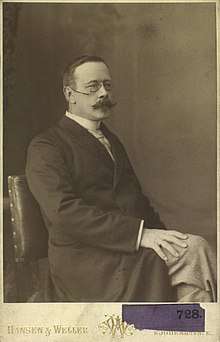Hans Christian Gram
Hans Christian Joachim Gram (13 September 1853 – 14 November 1938) was a Danish bacteriologist noted for his development of the Gram stain, still a standard technique to classify bacteria and make them more visible under a microscope.
Hans Christian Gram | |
|---|---|
 Hans Christian Gram by Hansen & Weller | |
| Born | Hans Christian Joachim Gram 13 September 1853 Copenhagen, Denmark |
| Died | 14 November 1938 (aged 85) Copenhagen, Denmark |
| Known for | Inventing the Gram stain |
| Scientific career | |
| Fields | Bacteriology |
| Doctoral advisor | Japetus Steenstrup |
Early life and education
Gram was the son of Frederik Terkel Julius Gram, a professor of jurisprudence, and Louise Christiane Roulund.
He studied at the University of Copenhagen, and was an assistant for botany to the zoologist Japetus Steenstrup. His study of plants introduced him to the basics of pharmacology and the use of the microscope.
Gram began medical school during 1878 and graduated in 1883. He travelled throughout Europe between 1878 and 1885.
Career
Gram stain
In Berlin, in 1884, Gram developed a method for distinguishing between two major classes of bacteria.[1] This technique, known as Gram staining, continues to be a standard procedure of medical microbiology. This work gained Gram an international reputation. The staining method later played a major role in classifying bacteria. Gram was a modest man, and in his initial publication he remarked, "I have therefore published the method, although I am aware that as yet it is very defective and imperfect; but it is hoped that also in the hands of other investigators it will turn out to be useful."
A Gram stain is made using a primary stain of crystal violet and a counterstain of safranin. Bacteria that become colored purple when stained are termed 'Gram-positive', while those that become red when counterstained are termed 'Gram-negative'.
Other work
Gram's initial work concerned the study of human red blood cells. He was among the first to recognise that macrocytes were characteristic of pernicious anaemia.
During 1891, Gram taught pharmacology, and later that year was appointed professor at the University of Copenhagen. In 1900, he resigned his professorship of pharmacology to become professor of medicine.[2] As a professor, he published four volumes of clinical lectures which became used widely in Denmark. He retired from the University of Copenhagen in 1923, and died in 1938.[2]
Popular recognition
On 13 September 2019, Google commemorated the anniversary of his birth with a Doodle for Canada, Peru, Argentina, Australia, New Zealand, Israel, India and some European countries.[3][4]
References
- Gram, H.C. (1884). "Über die isolierte Färbung der Schizomyceten in Schnitt- und Trockenpräparaten". Fortschritte der Medizin (in German). 2: 185–189.
An English translation is in Brock, T.D. (1999). Milestones in Microbiology 1546–1940 (2 ed.). ASM Press. pp. 215–218. ISBN 1-55581-142-6.
A translation is also at Brock, T.D. "Pioneers in Medical Laboratory Science: Christian Gram 1884". Hoslink. Retrieved 27 July 2010. - Jay Hardy. "Gram's Serendipitous Stain" (PDF). Retrieved 13 March 2016.
- "Hans Christian Gram's 166th Birthday". Google.com. 13 September 2019. Retrieved 13 September 2019.
- Michallon, Clémence (13 September 2019). "Who was Hans Christian Gram and what did the groundbreaking scientist discover?". Independent UK. Retrieved 13 September 2019.
External links
| Wikimedia Commons has media related to Hans Christian Gram. |
- Whitworth, Judith A.; Firkin, Barry G. (2002). Dictionary of medical eponyms. Carnforth, Lancs: Parthenon. ISBN 1-85070-333-7.
- Hans Christian Joachim Gram at Who Named It?